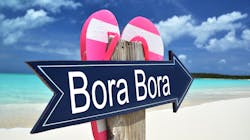Continuing Education: Trade Show Tune-Up
The last couple of years have been difficult for in-person networking and technical learning. Conferences, meetings and seminars shut down or became online events. Many online meetings continue as some companies maintain a push to reduce or eliminate travel costs. This is a mistake. What the last two years has shown is that human contact, networking and in-person presentation has value that online or virtual experiences can’t fully replace. I believe industry in-person meetings have tremendous training value to our employers and career value to ourselves.
Evidently, others have the same opinion. Last month, I attended a conference that had nearly record sign-up and attendance. Many others are searching for face-to-face contact as well.
Many of us are out-of-practice for in-person meetings. Plus, the industry has a backlog of people who might be going to their first meeting. A quick review of how to get the most benefit out of your next meeting is worth some time.
First, as much as possible, select the right meeting. Are you interested in technical content, business directions, industry-regulatory interaction, political trends or other factors? Each of our industries will have a range of meetings. Each meeting has its own balance of content and opportunity. Find the one that matches up with your general objectives. Are you interested in a technical career or does management, finance or another area look like a better fit for your future? Select a meeting that fits your agenda. Of course, some practical limits impose constraints. Getting to that pump reliability conference in Bora Bora is a stretch too far for most.
Second, once you know where you are going, define your detailed objectives for the specific meeting. This may be networking, meeting old friends, seeing vendor exhibits or technical content on specific subjects. You might be looking to solve a specific problem, increase general technical expertise for your current job or looking for new jobs, among others. Nevertheless, attempt to define a primary objective for yourself. After the primary objectives, it would be good to have two to three secondary objectives.
Third, once you have set primary objectives, match them up to the meeting program. What events or presentations would support each objective? See if you can balance the time allocated for each objective to your selection from the program. Smaller and more focused meetings may have only one track – essentially, one set of activities following each other through the meeting. Larger, and typically more complex meetings, often have parallel tracks organized around a selection of concepts. Figuring out what happens when (and where) is important to getting the most out of the meeting. Many parallel activities may overlap, and you may need to choose between competing options.
Today, nearly every event has its own online app with messaging options, updated schedules and last-minute announcements. Many of these try to imitate functions like those found on Facebook, LinkedIn or TikTok. Before using these, make sure you’re comfortable with their security and information policies. Personally, I find most meeting apps to have a debilitating combination of appalling security, bugginess, and lack of user-friendliness. I plan before the meeting, using available programs (printed or web pages) and print out an agenda for myself, but I’m prepared to modify the plan depending on circumstances.
Some cautions here: Be realistic about your energy levels. At some point, our body or spirit will give out if we go from the 6 a.m. breakfast meeting all day until we return from dinner at 11 p.m. You’re the only person who can decide your tolerance levels, but some downtime is typically useful.
The downtime, or unscheduled time, also allows for chance meetings or an opportunity to follow up on something that requires immediate attention. You can’t plan for serendipity, but you need to create some space for it to happen it.
One final note. Make sure you take plenty of business cards. Perhaps you won’t need them. But have them. Making contacts in person is a key benefit to the physical meeting. Take advantage of it.
Don’t forget to show why the meeting or seminar was valuable when you return to your regular work. Document a few things of value that you brought back. This is a good reminder to yourself of why you went. Documentation on benefits to the company also makes the value meetings clearer and makes it easier for everyone to go to the next meeting. Perhaps you will make the value so clear that next year someone can get to the Bora Bora pump conference [1].
[1] Just so everyone knows, the Bora Bora pump conference is fictional. Only doctors get conferences like that.
About the Author
Andrew Sloley, Plant InSites columnist
Contributing Editor
ANDREW SLOLEY is a Chemical Processing Contributing Editor.

